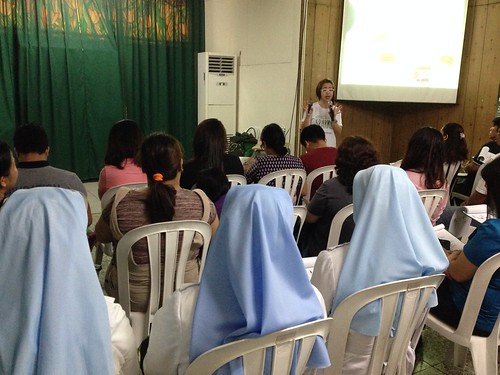ASP Chair Emeritus Dang Koe welcomed parents and teachers who attended the seminar entitled Autism Friendly Learning Environment held at the Autism Society Philippines National Headquarters last 29 July 2017.
 |
| Participants of the seminar with the speaker Ms. Dang Koe |
She stressed that Structured Teaching is a framework for teaching and is not a curriculum i.e. it shows how to teach, not what to teach. The structure that is provided is like a prosthetic device which in itself is a form of behavior management, is individualized, and can be faded as the child learns to be independent. She showed how ST’s four main components use the relative strengths (e.g. strong visual perceptual skills and rote memory) and special interests of persons with autism (PWAs), to minimize their learning difficulties.
Physical Space - Through the practical and actual examples in homes and different schools, Mama Dang showed that by arranging furniture, using shelves, rugs, tape on the floor, etc., one can define the purpose and boundaries of each activity space. By providing containers and labels, clutter is reduced and the child is more able to focus and he learns there is an appropriate place for every activity.As a finale, Mama Dang shared a short video of Gio, how he learned to do tasks independently through the years, a testament to how structured teaching helped him become as independent as he can be.Schedule - Giving the child a visual schedule gives him a sense of predictability and teaching him to follow a visual schedule develops flexibility. It also teaches the child the concept of “first-next”, and “finished.” Mama Dang showed the evolution of Gio’s schedule boards, both general schedules and task specific schedules (or task charts), as he grew and as his activities changed. She stressed that schedules need to be individualized both in form and content, depending on the child’s level of functioning.Work System - By identifying a process or protocol, i.e. always starting from top to bottom, left to right, the child gains independence in doing tasks.Task Structure - Improving the manner materials used in a task are organized, the child can see what he needs to do with much less instruction. Visual instructions are a big help in communicating to the child the sequence of steps for the task or activity he must do.
“The subject is relevant and applicable for parents and teachers.”“Presentation was well prepared.”“Very relevant to what I am supposed to do to my child as of his stage now.”


 Posted in:
Posted in: 

0 comments:
Post a Comment